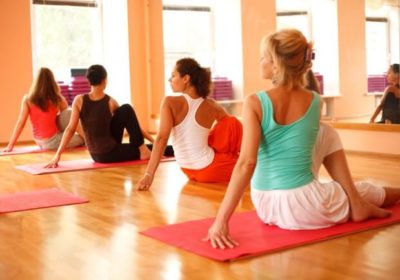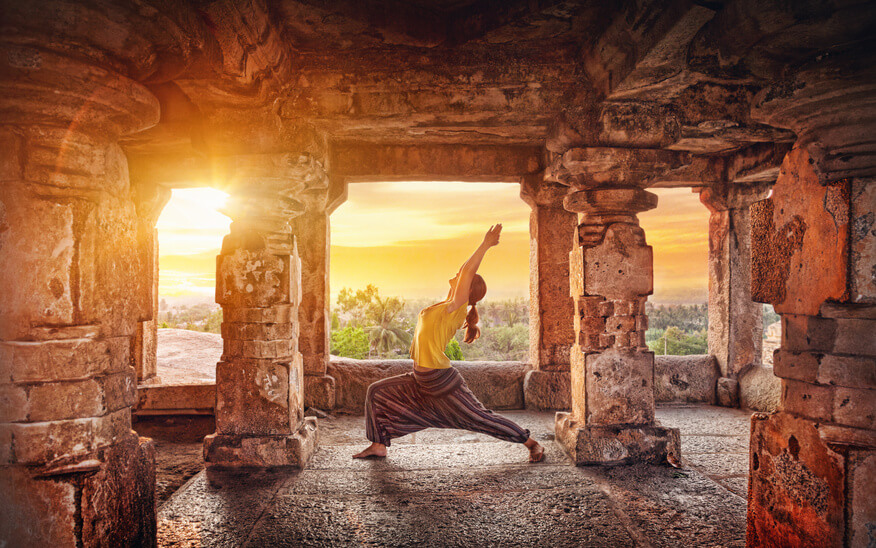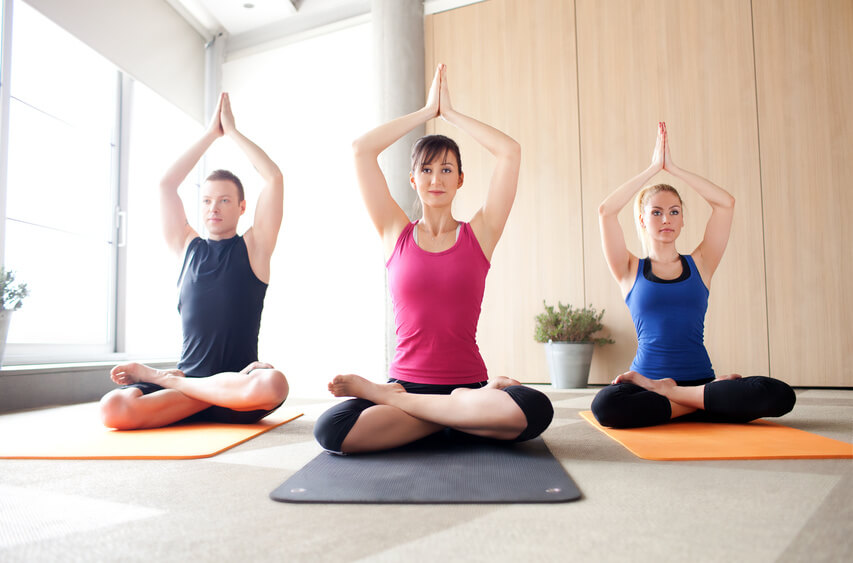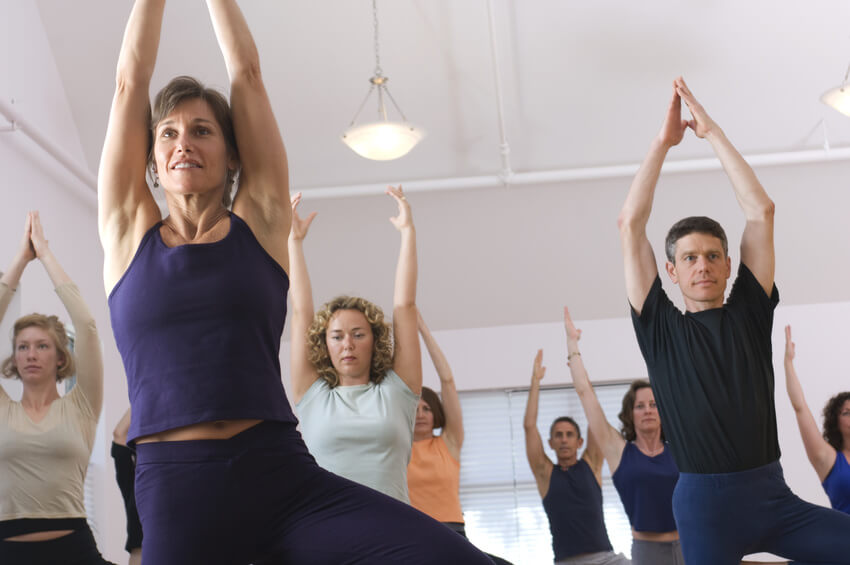Yoga 101: History, Popular Styles & Health Benefits

Yoga might sometimes seem like a relative newcomer to our busy lives, but it has actually been around for several millennia. Today, yoga exists in many different forms and has been linked to numerous health benefits.
In this introduction to yoga I am going to cover the history of yoga, the different styles that we see today, and the many proven benefits that yoga has for our health and wellbeing. You can click on the links below to jump between sections.
The History of Yoga
Today’s Most Popular Styles Of Yoga
Scientific Proof That Yoga Improves Your Health
References & Further Reading
Table Of Contents
The History of Yoga
When it comes to fully understanding and appreciating the intricacies of Yoga, the modern belief of leaving the past in the past and only looking ahead is certainly not the way to go. In order to fully grasp the varied concepts of Yoga, it is vital to educate oneself on the history of the practice and understand how it evolved into the activity in which we take so much joy in the present day.
 Though some say that Yoga is as old as civilisation itself, the earliest hard evidence can be traced to a set of stone seals depicting yoga poses that date back to 3000 B.C. Learned scholars on the subject, though, maintain that Yoga may be even older than this, going as far back as the time of Stone Age Shamanism.
Though some say that Yoga is as old as civilisation itself, the earliest hard evidence can be traced to a set of stone seals depicting yoga poses that date back to 3000 B.C. Learned scholars on the subject, though, maintain that Yoga may be even older than this, going as far back as the time of Stone Age Shamanism.
This is a sensible assumption as both Yoga and Shamanism share key values and interests concerning the improvement of the human condition, and though we recognise modern Yoga to be an activity very much about the self, the practice was originally more community-based before the change to inward focus.
Yoga’s long and detailed history can be most appropriately divided into four historical periods, these being the Vedic Period, the Pre-Classical Period, the Classical Period and the Post-Classical Period. [1]
The Vedic Period
This early period in the history of Yoga is marked by the existence of Vedas. Vedas is the sacred scripture associated with Brahmanism (the unchanging reality amidst and beyond the world, which cannot be exactly defined), which in turn is the basis and inspiration for modern-day Hinduism. The scripture is an anthology of hymns that praise and worship a divine and mighty power. Within the Vedas are the earliest recognised Yogic teachings and as a result, these specific teachings are known as Vedic Yoga. Vedic Yoga is generally associated with ceremonies and rituals that encourage one to try to escape the limitations of one’s mind.
During this early period, it was the duty of Rishis (Hindu saints or sages) [2] and dedicated Vedic Yogis to teach the people how to live in divine harmony. These Rishis were also regarded as being able to see the ultimate reality through their determined and concentrated Yoga practice. The Vedic Period is also marked as a time when some dedicated Yogis lived in seclusion, for example in forests, seeking a spiritual connection with nature.
The Pre-Classical Period
Yoga’s Pre-Classical Period is marked by the creation of the Upanishads. The Upanishads are a collection of two hundred scriptures that detail further religious and spiritual concepts relating to devotion to Brahman (the ultimate reality). The scripture focuses on the relationship between Brahman and Atman (the transcendental self), and the fact that true liberation is achieved when one acknowledges that the two are identical.
Yoga shares many of its key characteristics with Buddhism as well as Hinduism. It was during the sixth century B.C. that Buddha began educating people on his philosophies, and this teaching involved the importance of meditation and the beginnings of practising physical postures. It is believed that the first Buddhist to study Yoga, Siddharta Gautama, achieved enlightenment at 35 years old.
The Lord’s Song, or Bhagavad-Gita, was created in approximately 500 B.C. and is widely accepted as the oldest known scripture dedicated solely to Yoga. The text stresses the importance of being active in order to prevent difficulty in life, and that our actions have to transcend ego. Though the scripture is completely devoted to Yoga and confirms that the practice had, by that point, been prominent for some time, it does not allude to a specific time in which Yoga may have officially begun.
The Classical Period
The Classical Period is defined by yet another text, the Yoga Sutra. The Yoga Sutra was written by Patanjali in approximately the second century, and was a project that attempted to define the guidelines for and standardise Classical Yoga. The text is made up of 196 different sutras (rules) that elaborate on the underlying principles of yoga. They are known as the ‘Eight Limbs of Classical Yoga’, which are:
- Yama: Universal morality.
- Niyama: Personal observances.
- Asanas: Body postures.
- Pranayama: Breathing exercises, and control of prana.
- Pratyahara: Control of the senses.
- Dharana: Concentration and cultivating inner perceptual awareness.
- Dhyana: Devotion, Meditation on the Divine.
- Samadhi: Union with the Divine. [3]
Patanjali held the belief that every individual is a fusion of spirit (purusha) and matter (prakriti), and that these two components must be separated in order to truly cleanse the spirit. This is a marked departure and progression from the Vedic and Pre-Classical thought that the Brahman and Atman were one and the same. Patanjali’s notion of Yoga remained the prominent force for centuries, with some Yogis dedicating more time to meditation than to physical exercise. It was only later that the focus on Asana was revived and the familiar notion of treating one’s body as a temple was rekindled.
The Post-Classical Period
The Post-Classical Period signals a move into much more modern times, and the evolution of Yoga as being much more about the present than the past. Rather than liberating a person from reality, the copious amounts of contemporary literature dedicated to Yoga now strive to teach how make the most of life in the present moment.
Introduced to the West in the early nineteenth century and associated with the health and vegetarianism kick of the 1930s, there began to be a more wide stream interest in the activity by the 1960s when an increase in the presence of Indian teachers began to introduce people to Yoga. One such teacher was Maharishi Mahesh, who was responsible for popularising transcendental meditation. Another, Yoga Guru Swami Sivananda, opened schools across Europe and America, spreading the word based on a number of his works, the most famous being the Five Principles of Yoga:
- Savasana: proper relaxation.
- Asanas: proper exercise.
- Pranayama: proper breathing.
- Proper diet.
- Dhyana: positive thinking and meditation. [4]
Moving forward to the current day, Yoga continues to spread and evolve. It is rapidly breaching cultural boundaries and language barriers to become an even more popular activity across the globe.
Today’s Most Popular Styles Of Yoga
 Now that we have covered the history of Yoga, it is time to explore some of the most popular ways in which people enjoy Yoga in the twenty first century.
Now that we have covered the history of Yoga, it is time to explore some of the most popular ways in which people enjoy Yoga in the twenty first century.
These include, but are not limited to, Anusara, Ashtanga, Bikram, Hatha, Hot Yoga, Iyengar, Restorative and Vinyasa [5]. Let’s break these different styles down and find out what each entails.
- Anusara
A relative newcomer to the ever-expanding world of Yoga, anusara was created by an American yogi named John Friend in 1997. Anusara works on the principle that every human being is filled with an inherent goodness, and through the use of physical practice, they can work to free their hearts, experience joy and allow their inner virtue to come to the fore. Anusara classes are known for being rigorous and challenging both for the body and for the mind. - Ashtanga
Ashtanga is a style of Yoga that was bought to the West and made popular by Pattabhi Joi in the 1970s. Inspired by ancient Yoga teachings, it is a fairly rigorous process of following specific sequences of postures that are focused on breathing. A very rigid style of Yoga, these poses are performed in exactly that same order every time, and Ashtanga can be a very physically demanding and sweat inducing method. - Bikram
Bikram Yoga is a style of Yoga that was developed roughly thirty years ago by Bikram Choudhury. The unique nature of Bikram is that the classes take place in rooms that have been artificially heated, leading participants to sweat heavily whilst following a strict sequence of twenty six poses. Though there has been some notable controversy involving Choudhury’s mission to sue studios who do now exactly follow his trademarked routine, Bikram has become one of the most well know and popular styles of Yoga in recent times. - Hatha
Hatha Yoga is a non-specific term for any practice that utilises physical poses and postures. The overwhelming majority of classes taught in the West can be classed as Hatha, and the common tone of a session generally involves being given a gentle introduction to some of the common and less strenuous Yoga poses. Hatha is an ideal place to start for Yoga beginners, ensuring a relaxed and low difficulty level workout but guaranteeing the feeling of having loosened your body for the better. - Hot Yoga
Hot Yoga is essentially the same type of work out as Bikram, with the key difference between the two being that classes calling themselves Hot Yoga classes can deviate and mix up the posture sequence that has been trademarked by Bikram Choudhury for his specific brand of Yoga. It is still conducted in heated rooms and you will still sweat profusely whilst exercising. - Iyengar
Iyengar Yoga is named for prominent Yoga teacher BKS Iyengar. It is a form of Hatha yoga with a particular emphasis on the correct implementation of postures (asanas). Where necessary, this can involve the use of props such as blocks, belts and blankets to facilitate improved technique. - Kundalini
Sometimes known as Iaya Yoga, Kundalini is based on work by Sivananda Saraswati in the 1930s. It was originally a closely guarded secret, practiced by only a handful of people. However, from 1969 onwards it was popularized by Yogi Bhajan. This is a more spiritual form of Yoga, with a greater emphasis on breathing techniques, chanting and meditation. - Restorative
Restorative Yoga is a relaxing and low maintenance style of Yoga that is perfect for those who want to feel invigorated and soothed without having to exert a high level of effort. Students use props such as blankets and blocks to assume suitable postures and feel the benefit of them without having to cope with the strain of holding the pose unaided. Restorative Yoga can help to rejuvenate the body and is often staged at studios on a Friday night to help people rewind after a long hard week at work. - Satyananda
Taught at the Bihar School of Yoga, Satyananda Yoga is a systematic approach to developing a healthy body and a clear and focused mind, leading to a sense of being more at ease with yourself and the world around you. - Vinyasa
Derived from the Sanskrit word meaning ‘flow’, Vinyasa Yoga classes are distinguishable for a very fluid, movement intensive style of exercise. The skilled Vinyasa teachers design and choreograph their lessons for poses to transition smoothly and almost effortlessly from one to another, and the use of music is extremely popular to maintain a rhythmic movement throughout. The demand and intensity of the style is comparable to Ashtanga, but Vinyasa as a whole is much more flexible, with routines varying from class to class. Vinyasa is an ideal choice for those who like to mix things up rather than stick to a solid schedule.
As you can see, there are a plethora of different Yoga style options for you to explore and choose from. It is a matter of testing the waters with a handful of varied types and finding the style that best suits your lifestyle. It is so important to find the style that fits your day-to-day routine. Once you do, you will find that Yoga can become a truly enjoyable and integral part of your life.
Scientific Proof That Yoga Improves Your Health
 So, you’ve read up on the history of the practice, you have done some research and decided which style of Yoga best suits your personal tastes, you are pretty much set to begin a lifetime of poses and inner peace. But is there any definitive evidence to suggest that Yoga can be medically beneficial, as well as bringing relaxation and a positive state of mind to your life?
So, you’ve read up on the history of the practice, you have done some research and decided which style of Yoga best suits your personal tastes, you are pretty much set to begin a lifetime of poses and inner peace. But is there any definitive evidence to suggest that Yoga can be medically beneficial, as well as bringing relaxation and a positive state of mind to your life?
Hundreds of studies have been commissioned to find exactly if and how Yoga can make an impact in real medical and health terms, and the results have indicated that there are several populations and groups of people for whom the activity of Yoga can be extremely beneficial.
The groups that seem to benefit most are adults with cancer, children with autism, caregivers, military veterans with PTSD, victims of domestic violence, older adults with cognitive impairments and adults with substance abuse/addiction. [6] Note that this is far from a complete list – these are just the groups which have been subject to research studies.
Adults With Cancer
The largest number of hospital-sanctioned Yoga programs and classes are for the benefit of adults suffering or recovering from cancer. A recent study undertaken by Ohio State University [7] examined a Yoga class of two hundred breast cancer survivors. They were encouraged to discover that three months worth of twice-weekly Hatha Yoga classes resulted in a significant drop in fatigue and a spike in energy and verve compared to their peers who were not involved in the project. There was also a markedly lower level of bodily inflammation among the patients who participated in the Hatha Yoga classes, an indicator of what the exercise can do for the body’s immune system markers.
Children With Autism
In contemporary society there has been an alarming rise in the number of young children diagnosed with disorders within the autism spectrum, and as a result, a number of modern studies have taken place to try to ascertain ways for parents and carers to help the affected children in their day-to-day lives. In search of answers, a number of Yoga programs were developed especially for children with autism, and one such program [8] engaged twenty-four elementary school age students in a daily yoga experiment for a period of sixteen weeks. Compared to group of similar children who had not taken part in the Yoga activity, researchers noted that the students showed a significant decrease in inappropriate or maladaptive behaviour.
Caregivers
Being solely responsible for the care of a disabled loved one or patient can be an extremely draining and stressful life to lead, a demanding job from which you can never take a real holiday. The role of a caregiver is often taken for granted by those who are not involved, and studies have helped to prove that Yoga can be extremely beneficial to the well being of individuals who assume that particular responsibility. In a study documented in the Indian Journal of Psychiatry [9], forty-three caregivers were assigned to participate in a range of Yoga activities including pranayama and asanas, and after one month researchers recorded and significant drops in levels of anxiety and depression amongst the group, as well as an overall improved quality of life and personal well being.
Military Veterans With PTSD
It is generally estimated that as many as 20% of veterans of the Iraq and Afghanistan conflicts suffer with varying levels of post traumatic stress disorder (PTSD). Yoga has been identified as one the newest and most popular therapies that is used to assess potential changes in depression, anxiety and sleeplessness amongst these sufferers. A recent study by the Southeast Louisiana Veterans Heath Care System [10] engaged with twelve PTSD-suffering veterans and encouraged them to attend twice-weekly Yoga classes for six weeks. The study resulted in noticeable improvements in the sleeping patterns and sleeping quality of the veterans, concluding that the Yoga exercises were helping to achieve some new and beneficial peace of mind.
Victims Of Domestic Abuse
Different styles of Yoga have been mentioned as a potentially beneficial therapy for victims of domestic abuse who are suffering from a mixture of anxiety, depression and PTSD. Though little extensive research has been carried out on this particular topic, scientists believe that the process of reflecting and meditating combined with endorphin releasing exercise could be extremely beneficial. A related study by the Department of Psychology at Fayetteville State University [11] noted the impact of yoga breathing exercises on the feelings of depression among a group of abused women.
Older Adults With Cognitive Impairments
The curse of dementia is more prevalent than ever as our population continues to age. With medical professionals doing all they can to fight against cognitive impairment, Yoga has been suggested as a safe and immediate option. A research project carried out in India [12] led to a group of forty four residents of elderly homes completing a six month period of light Yoga. This produced results indicating marked improvements in attention span, memory, thought speed and executive function. This alludes to the fact that long-term yoga practice can help to maintain your brain function.
Adults With Substance Abuse/Addiction
Yoga, along with many other more modern and contemporary options, has been suggested as a therapeutic option for adults suffering from substance abuse and addiction. A recent trial [13] researched the effect that practicing Yoga had on the mood and well being of seventy five Chinese females who were in treatment for heroin addiction and withdrawal. The women were asked to undergo a six month long program of Yoga that resulted in a significant positive change in the overall mood and quality of life of the participants.
As you can see, a number of different studies have indicated a real, scientific advantage from Yoga. This is in addition to the more general positive feeling that exercise and meditation can give us.
The combinations of mental and physical exertion that exist in Yoga mean that this lifestyle choice can be taken up by absolutely anybody, from a child to an elderly person. It is this incredible versatility that has resulted in the ever-expanding popularity of Yoga, a practice that has stood the test of time and is only becoming stronger with age. If you are low in energy or in poor health, due to Candida or any other reason, give it a try!
References & Further Reading
- ABC of Yoga, “History of Yoga – A Complete Overview of the Yoga History”, http://www.abc-of-yoga.com/beginnersguide/yogahistory.asp
- Wikipedia, “Rishi”, http://en.wikipedia.org/wiki/Rishi
- William JD Doran, “The Eight Limbs , The Core of Yoga”, http://www.expressionsofspirit.com/yoga/eight-limbs.htm
- ABC of Yoga, “Principles of Yoga – The Five Principles of Yoga”, http://www.abc-of-yoga.com/beginnersguide/yogaprinciples.asp
- Gaiam Life, “A Beginner’s Guide to 8 Major Styles of Yoga”, http://life.gaiam.com/article/beginners-guide-8-major-styles-yoga
- Dr. Lawrence Rosen, “7 Scientific Examples Of When Yoga Is The Best Medicine”, http://www.mindbodygreen.com/0-13507/7-scientific-examples-of-when-yoga-is-the-best-medicine.html
- Kiecolt-Glaser et al. (2014), “Yoga’s impact on inflammation, mood, and fatigue in breast cancer survivors: a randomized controlled trial.”, http://www.ncbi.nlm.nih.gov/pubmed/24470004
- Koenig et al. (2012), “Efficacy of the Get Ready to Learn yoga program among children with autism spectrum disorders: a pretest-posttest control group design.”, http://www.ncbi.nlm.nih.gov/pubmed/22917120
- Umadevi et al. (2013), “Effect of yoga therapy on anxiety and depressive symptoms and quality-of-life among caregivers of in-patients with neurological disorders at a tertiary care center in India: A randomized controlled trial.”, http://www.ncbi.nlm.nih.gov/pubmed/24049204
- Staples et al. (2013), “A yoga program for the symptoms of post-traumatic stress disorder in veterans.”, http://www.ncbi.nlm.nih.gov/pubmed/23929045
- Franzblaue et al. (2008), “A preliminary investigation of the effects of giving testimony and learning yogic breathing techniques on battered women’s feelings of depression.”, http://www.ncbi.nlm.nih.gov/pubmed/18319369
- Hariprasad et al. (2013), “Randomized clinical trial of yoga-based intervention in residents from elderly homes: Effects on cognitive function.”, http://www.ncbi.nlm.nih.gov/pubmed/24049199
- Zuang et al. (2013), “Yoga effects on mood and quality of life in Chinese women undergoing heroin detoxification: a randomized controlled trial.”, http://www.ncbi.nlm.nih.gov/pubmed/23715475

